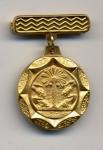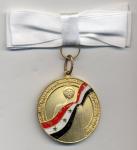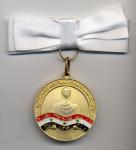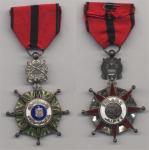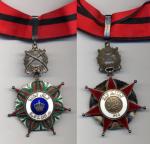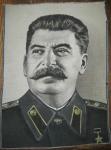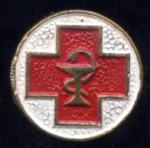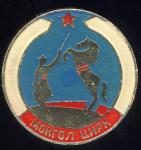-
Posts
14,343 -
Joined
-
Last visited
-
Days Won
25
Content Type
Profiles
Forums
Blogs
Gallery
Events
Store
Everything posted by Ed_Haynes
-
RE: Order of Civil Merit To follow up on the post above, a comparative shot of the third class/second class and decoration/knight/fourth class
-
Order of Bravery Awarded to members of the armed forces for courage and valor during military operations. It may also be awarded for more generalized courage of exceptional service in the public interest. In 1976 (?) award of the medal was extended to civilians and foreigners. The order is awarded by class, according to rank, as is detailed below. Also seen referred to as the "Valor Medal". Established: By Legislative Decree No. 15 of 20 July 1964 and amended by ??? of ??? 1976 (?). Obverse: Gilt, an eight-pointed rayed star with a circular central medallion showing a horseman charging toward the left. Around the bottom of this central medallion is a green-enameled semi-circular wreath. The size of the badge differs by class, as detailed below. The medal is suspended from a ring executied with a wreath motif. Reverse: Blank. Ribbon: Dark blue, three 1.5 mm red stripes edged with 1.5 mm white stripes. Subsequent awards of each class are indicated by a bronze oak leaf worn on the ribbon. --- first class - awarded to officers --- second class - awarded to non-commissioned officers --- third class - awarded to enlisted personnel All three classes, but a nasty scan, sorry.
-
-
Medal of 8 March Awarded to commemorate the coup, 8 March 1963, in which the Ba'ath Arab Socialist Party took control of Syria's government. This coup established Salah ad-Din al-Bitar (co-founded of the Ba'ath Party) as prime minister. While Major General Amin al-Hafiz would come to dominate this administration, this coup, and al-Bitar's role in it, is an important milestone in understood recent Syrian history. The medal was awarded to all members of the armed forces who were serving on 9 April 1963 (the day after the coup). In 1965, award was extended to those who were recalled to service in the period between 9 April 1963 and 28 April 1965 (the date of the amending decree). This is also seen referred to as the "Medal for Underground Fighters". Established: By Legislative Decree No. 15 of 9 April 1963 and amanded by Legislative Decree No. 789 of 28 April 1965. Obverse: 39 mm, gilt, sixteen-pointed, in center a hand clasping a torch with an outline map of the Arab world behind. This is surrounded by a white-enameled band edged in red enamel with Arabic inscription in black "Unity / Freedom / Socialism / 8 March 1963". Suspended by a ring. Reverse: Plain. Ribbon: Dark burgundy, with three 1.5 mm stripes of dark green edged with 1.5 mm white stripes. EDITED: Oops, wrong image.
-
Nice mini-flock. See http://gmic.co.uk/index.php?showtopic=10216 where there is a focused discussion of these.
-
Nut Himayat al-Atfal fi al-Iraq, 1941 / Medal for Children's Wefare in Iraq, 1941 Established: 1941. Obverse: The medal is a flat, silver seven-pointed star. Centered towards the top is a smaller, white-enameled seven-pointed star. There is an Arabic inscription in black, "Nut Himayat al-Atfal fi al-Iraq" or "Medal for Children's Welfare in Iraq" below the white star and the year "1941" in Arabic. Ribbon: Three equal stripes of red, white, and red. Also described as red with 5-mm white edge stripes? Only a miniature, sorry.
-
-
-
-
-
Air Force Service Order Established: aft. 1969? Obverse: An eight-pointed rayed star with a blue enameled central circle breing a winged device with a red flame above. Above the wings, the Arabic words "Belief / Life / Power". Worn as a neck badge suspended from an eagle. Reverse: Blank. The reverse of the suspension eagle has the legend "MILLED-CHILE". Ribbon: very narrow medium blue neck ribbon. --- first class - silver-gilt (SHOWN BELOW) --- second class - silver
-
Nut al-'Amal / Medal of Work Awarded to members of the Ba'ath Party who rendered specially meritorious service to the party. Also referred to as the "Workers' Medal" and the "Medal of Labor". The "Medal of Work" is a successor/redesign/renaming of this award. Established: Before 1982? Obverse: Circular medal with a stylized representation of a heroic worker raising a torch in the center. Above "Wissam al-'Amal" or "Order of Work" and, below, "Umma Arabiya Wahida That Risala Khalida" or "One Arab Nation and One Aim". Suspended by a ring. The medal has been observed in both gilt and silver (is there a bronze variety?), but the significance is unknown. Reverse: The legend surrounding "Iraqi Government / Liberty in Socialism". In the center, the legend "This medal was given by the Department of Labor and is numbered [number]. [C.E. year of issue]" (but it usually isn't). Ribbon: The award is seen with ribbons of black, green, dark blue, and maroon. It is uncertain what is the significance of there differing ribbon colors. gilt medal: --- black ribbon (SHOWN BELOW) --- green ribbon --- dark blue ribbon --- maroon ribbon silver medal: --- black ribbon --- green ribbon --- dark blue ribbon --- maroon ribbon bronze medal (?): --- black ribbon (?) --- green ribbon (?) --- dark blue ribbon (?) --- maroon ribbon (?)
-
Wissam al-'Amal / Order of Labor Awarded to members of the Ba'ath Party who rendered specially meritorious service to the party. The "Medal of Work" is a successor/redesign/renaming of this award. Established: By Section 145A of the Work Law No. 151, as amended in 1970. ??? Law No. 8 of 1975. Designed by Mohammed Ghani Hikmat. Obverse: Circular medal with a stylized representation of a heroic worker raising a torch in the center. Above "Wissam al-'Amal" or "Order of Work" and, below, "Umma Arabiya Wahida That Risala Khalida" or "One Arab Nation and One Aim". Suspended by a ring. The medal has been observed in both gilt and silver (is there a bronze variety?), but the significance is unknown. Reverse: Across the center, a stylized represenattion of the pre-1991 Iraqi flag. Above, "Al-Jamhuriya al-Iraqiya" or "The Iraqi Republic" and, below, "Muniha Hatha al-Wisam bi Mojib al-Mada 145 A min al-Qanun al-'Amal Arqam 151 lisanat 70 al-Muadal". Ribbon: The award is seen with ribbons of black, green, and dark blue (and maroon also?). It is uncertain what is the significance of there differing ribbon colors. Many specimens are seen with an oblong bar from which the ribbon is suspended. gilt medal: ---black ribbon ---green ribbon ---dark blue ribbon silver medal: --- black ribbon (SHOWN BELOW) --- green ribbon --- dark blue ribbon bronze medal (?): --- black ribbon (?) --- green ribbon (?) --- dark blue ribbon (?)
-
-
Wisam al-Rafidain / Order of the Two Rivers Named for the two great rivers of Iraq, the Tigris and Euphrates, this order is awarded for exceptional service to Iraq. It exists in both military and civil classes. Two distinct varieties of the badge exist, the pre-Revolutionary royal variety with central crown, and the Republican version, with the crown predictably replaced with the Republican eagle. There are two versions of the Republican badge, distinguished by different inscriptions, as detailed below. The civil version is suspended by a wreath, the military division by a wreath with crossed swords. For the first - royal - version, the crown is prominently featured on the obverse obverse and the inscription reads: "Al-Mamlaka al-Iraqiah / Hub al-Watan min al-Iman" or "The Iraqi Kingdom / Loving the Country is Faith". In 1959, the badge was redesigned after the Revolution by, predictably, removing the royal crown from the obverse and replacing it with the Republican eagle. In 1963, the obverse inscription was altered. More details on changes in the badge design are given below. Established: In 1922 by King Faisal I. The order was revised and redesigned by Law No. 87 of 24 May 1959 after the overthrow of the monarchy and the establishment of the republic. In 1963, the obverse inscription was altered. ??? Law No. 28 of 1967. A collar was established by Law No. 1 of 1968. For most of its history, the insigniae seem to have been manufactured by Arthus Bertrand (Paris, France). Believed also to have been manufactured by Garard (London, England), ca. 1935-58 and by Arthus Bertrand (Paris, France) before 1935. Obverse: A circular silver star, maroon-enameled, of seven points, each point ending in a ball. Between the points, a wreath in green enamed with white (lotus?) flowers. In the center, a white circle with an Arabic inscription "Al-Mamlaka al-Iraqiah / Hub al-Watan min al-Iman" or "The Iraqi Kingdom / Loving the Country is Faith". Inside this circle, there was until 1959, a gold crown on a blue background; after 1959, this crown has been replaced with the silver eagle of the Republic. From 1959 until 1968, the inscription read "Al-Jamhuriya al-Iraq / Hub al-Watan min al-Iman" or "The Republic of Iraq / Loving the Country is Faith"; after 1968, it legend was altered. The civil division is suspended by a wreath, while the military division adds crossed swords to this wreath. Reverse: Until 1959, the legend "Al-Adil asas al-Mulk / Faisal al-'Awal / 1345 A.H." or "Justice is the Basis for the Kingdom / Faisal I / 1345 A.H.". In 1959 the legend was altered to "Al-Rafidian / 1377 A.H. / Al-Sh'ab" or "The Two Rivers / 1377 A.H. [=1960 C.E.] / The People" After 1968, in the circular silver center, an Arabic inscription "Al-Jamhuriya al-Iraq / Hub al-Watan min al-Iman" or "The Republic of Iraq / Loving the Country is Faith". Surrounding this, on a white-enameled circle, an Arabic inscription in gold, "? 1377 / j?r?A" "Al-Sh'arah / 1377 H" or "The Year / 1377 A.H. [= 1960 C.E.]". Ribbon: Military class: Red moir?, with thin black stripes at each edge and in the center. Civil class: Red moir? with two black stripes in from each edge. Also reported as simply red with a black central stripe? First badge, with crown, obverse inscription "Al-Mamlaka al-Iraqiah / Hub al-Watan min al-Iman" or "The Iraqi Kingdom / Loving the Country is Faith" and reverse legend , 1922-59: Military: first class - sash (worn over ???) shoulder), sash badge, and breast star (worn on ??? breast) second class - neck badge (SHOWN BELOW)third class - silver-gilt breast badge with rosette fourth class - silver breast badge medal of merit - silverCivil: first class - sash (worn over ???) shoulder), sash badge, and breast star (worn on ??? breast) second class - neck badge third class - silver-gilt breast badge with rosette - obverse fourth class - silver breast badge medal of merit - silver Second badge, crown removed, first obverse inscription, 1959-68: Military: first class - sash (worn over ???) shoulder), sash badge, and breast star (worn on ??? breast) second class - neck badge third class - silver-gilt breast badge with rosette fourth class - silver breast badge medal of merit - silverCivil: first class - sash (worn over ???) shoulder), sash badge, and breast star (worn on ??? breast) second class - neck badge third class - silver-gilt breast badge with rosette fourth class - silver breast badge medal of merit - silverSecond badge, crown removed, second obverse inscription, 1968-2003: Military: collar first class - sash (worn over ???) shoulder), sash badge, and breast star (worn on ??? breast) second class - neck badge third class - silver-gilt breast badge with rosette fourth class - silver breast badge (SHOWN BELOW)medal of merit - silver Civil: collar first class - sash (worn over ???) shoulder), sash badge, and breast star (worn on ??? breast) second class - neck badge third class - silver-gilt breast badge with rosette fourth class - silver breast badge medal of merit - silver
-
Nice to see documented sets (they are sets, right?). Any of these numbered with matching document? When did North Korea stop numbering their awards (or did they)?
-
-
Just obtained from Ulanbaatar two of those PCR-made silk wall hangings that are so familiar from the GPCR and pre-GPCR period. (I have a full set of Revolutionary Heroes.) These, from Mongolia, are slightly different, and slightly more interesting. First, a Friend from the North, 10 inches x 13.5 inches (trimmed?).
-
I understand. But you have the images!
-
Thanks, Eitze! One more incredibly rare Scandaluzzi book that I wish I owned!!
-
Fascinating! Many thanks, Tang Si!
-
W NIB 09 and W NIB 10 -- Sport Master What seen to be earlier (W NIB 09) and later (W NIB 10) versions of the familiar Sport Master badge (W 04).
-
W NIB 08 -- Mongolian Racing This is an amazing badge, and I suspect it will not scan well. The image of the horse and rider is custom-carved from a dark green stone (jadeite of some sort?) and is highly three-dimensional. A tiny work of wearable art!
-
-










